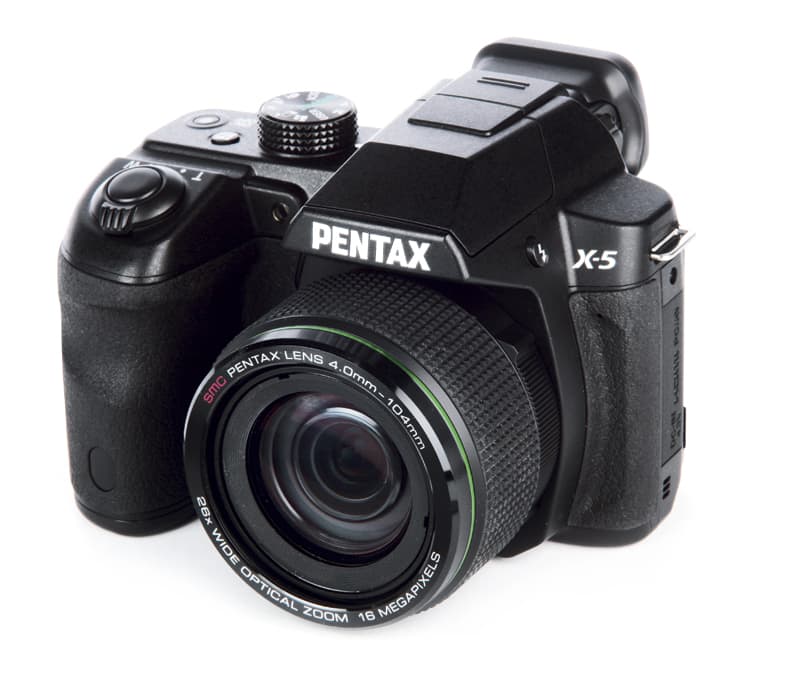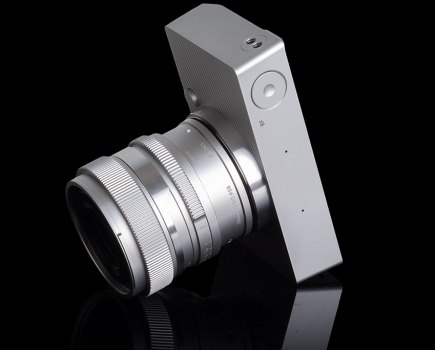Pentax X-5 at a glance:
- 16-million-pixel back illuminated CMOS sensor
- 26x zoom (22-580mm equivalent)
- 3in, 460,000-dot tilt LCD screen
- Full HD 1080p, 30fps video recording
- 10fps burst mode
- Street price around £200
Pentax X-5 review – Introduction
Almost three years ago when Pentax’s last bridge camera, the X90, was released, it featured a class leading 26x optical zoom. Fast forward to 2012 and we have seen a 50x zoom in the Canon PowerShot SX50 HS, a constant f/2.8 aperture in the 24x optical zoom of the Panasonic Lumix DMC-FZ200, and an imaging sensor in the Fujifilm X-S1 that is about twice the size of those used in other models. Manufacturers are including many new features in their cameras in order to get them noticed. Therefore, the new Pentax X-5, which replaces the X90, has much to build on in order to get up to speed in this competitive part of the market.
Features
The main feature of a bridge camera will always be its lens, and here the Pentax X-5 offers a 26x zoom. It is certainly not class leading, as nowadays some travel-zoom compacts come close, but the range still makes the X-5 hugely versatile. In fact, the X-5 has an ‘ultra-wide’ 22.3mm setting, matched only by the recently announced Olympus SP-820UZ, while at its 580mm telephoto setting the X-5’s maximum aperture is reduced from f/3.1 to f/5.9.
For these telephoto settings to be used effectively, the camera needs to be stabilised. In the X-5, Pentax has the advantage of its unique sensor-shift shake-reduction system, which also features in the company’s DSLRs. Pentax has introduced a digital shake reduction (SR) mode that works with the sensor-shift SR to produce a dual shake-reduction system.
Images are recorded onto a back-illuminated CMOS sensor. This type of sensor supposedly reduces the level and effect of noise on image quality, which is important in a bridge camera like the X-5 because it uses a compact-sized 1/2.33in (6.08×4.56mm) unit that is prone to noise. The sensor contains 16 million effective pixels for a maximum output of 4608 x 3456 pixels and a file size of 4-5MB.
The X-5 offers 1080p HD video recording at 30fps. Videos up to 25 minutes can be captured via the direct record button on the rear of the camera. There are also a number of shooting modes to choose from, including a high-speed continuous 30-frame burst at 10fps, 12 digital filters and creative image-processing tools.


Images: The wide 22mm setting is class-leading. At the 580mm setting, composition is tricky, but shooting at 1/400sec sharp results were achieved (Left: 22mm, right: 580mm)
Build and handling

First impressions of the Pentax X-5 are very positive. The camera’s pronounced handgrip has a faux leather finish, and is grooved while its deep profile affords a firm grip. So, not only is the camera comfortable to hold, but it is also well balanced and light enough to shoot with one hand or carry around all day on a shoulder.
Start-up is fast, with the X-5 ready to shoot in 2secs. The lens zoom is controlled by the rocker next to the shutter-release button, and its wide 26x optical zoom range takes about 2secs to go from the wide to the telephoto setting. Use the digital zoom and the range is extended to 187.2x, but the quality of the images in these settings is noticeably compromised. The digital zoom extension can be deactivated to prevent accidentally choosing one of these settings.
At the 580mm setting it is much more difficult to keep the X-5 steady when shooting handheld, and the maximum aperture is reduced to f/5.9. Dual SR then compensates for camera shake, and while I found that with a steady hand I was able to shoot at 1/125sec and often get a sharp image, it is better to shoot at around 1/400sec or faster.
Thankfully, a tilt function has been introduced to the LCD screen in the X-5, which aids clear viewing from both high and low viewing angles. Without the tilt function in use, the moderately bright 3in, 460,000-dot screen can be tricky to view. Images can also be composed and viewed using the built-in EVF. I suspect photographers will use the LCD screen more frequently, because the 230,000-dot display of the EVF lacks the vibrancy and crispness to display the final image accurately.
Pentax has opted to use four AA batteries to power the camera, so it is worth buying rechargeable batteries to save money on new batteries every time they run out.
Aperture and shutter priority shooting modes are not available, possibly because the camera features only two available apertures at any given focal length. For those who want control over the exposure, manual exposure is possible, and can be adjusted using the rear dial and the exposure compensation button on the top-plate.
Performance

These images show 72ppi (100% on a computer screen) sections of images of a resolution chart, captured with the lens set to its 100mm point. We show the section of the resolution chart where the camera starts to fail to reproduce the lines separately. The higher the number visible in these images, the better the camera’s detail resolution is at the specified sensitivity setting.
Compromises have to be made with a camera that has a compact-sized imaging sensor offering such a wide zoom range in a single lens.
The quality of detail that is captured is perhaps the most significant downside to a bridge camera, as is the case with the X-5. Given the target audience, processing power and price point of the camera, it shoots JPEG format only. In a landscape, fine detail such as grass appears either mushy or as a single green mass. There is also a softness to the edge detail of subjects in all but close range subjects in bright light.
Our resolution charts indicate that the X-5 is capable of resolving to the 24 marker at ISO 100, which is on par with the best performing bridge cameras. There is a drop in overall image quality at ISO 400, and then again at ISO 1600 and each ISO rating after that. Detail is soft at best, but this is even more noticeable down the ISO range.
As with most cameras at this level, the evaluative metering of the X-5 produces print-ready images. Midtones are bright and punchy, but in scenes of high contrast the highlight detail is usually lost. This suggests the camera has a modest dynamic range. In bright conditions, it is best to use manual exposure with around 0.7EV reduction dialled in, which is indicated on the screen.
Compact cameras tend to produce ‘less-believable’ colours than cameras with larger imaging sensors. This is the case with the X-5, especially when using the landscape scene mode, where colours are overly saturated. Overall, the auto white balance is a little cool for my liking, but a custom white balance addresses this.
For everyday use, the autofocus of the X-5 is perfectly capable, without being outstanding. The standard focus mode uses 25 centrally placed AF points, which are individually selectable in spot AF. Manual-focus operation is intuitive and covers from infinity to 1cm macro.

Image: The AWB setting produces a cool colour rendition in this scene, which was shot on a bright day with light cloud cover. The detail in the sky has burnt out quickly, and the edge detail of the building and branches against the sky suffers from chromatic aberrations
Our verdict
There is no doubt that Pentax has made radical improvements across the board to the X90 in producing the X-5. Those who tend to shoot landscapes should appreciate the camera’s class leading wideangle focal length, and the camera feels good in the hand, too. At its affordable price point, this is a very competitve camera. However, in a market where manufacturers have included so many new features to make them stand out from the crowd, the X-5 sinks into the background.









